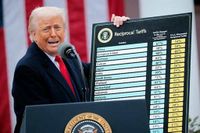Nike shares plummeted on Thursday, April 3, 2025, following a startling announcement from President Donald Trump regarding new tariffs that could significantly impact the company’s operations. The sportswear giant’s stock fell as much as 15%, erasing over $10 billion in market value. This drop came as part of a broader market decline, with the S&P 500 index also dropping more than 4% on the same day.
The crux of the turmoil stems from Trump’s declaration of a steep 46% tariff on imports from Vietnam, where Nike has established a massive manufacturing presence, employing more than 450,000 workers across 130 factories. Notably, Vietnam accounts for approximately 44% of Nike’s total product sourcing, making the company particularly vulnerable to the proposed tariffs.
In addition to the Vietnamese tariffs, the White House also announced a 34% tariff on goods imported from China, which supplies about 11% of Nike’s products. Analysts have expressed concerns that if these tariffs are implemented, Nike may be forced to raise prices on its products or restructure its supply chain, potentially moving operations outside of Asia. Stifel analyst Jim Duffy estimates that these changes could lead to a reduction of $1.69 per share in Nike’s earnings.
"Companies that worked hard over the years to reduce reliance on China by leaning into countries like Vietnam just learned there really isn't a place to hide," said Simeon Siegel, an analyst at BMO Capital Markets. Nike has more pricing power than many of its competitors, but as Bernstein analyst Aneesha Sherman noted, "They can’t price gauge their way out of this." In light of these challenges, Nike is now focused on damage control, renegotiating contracts with vendors and suppliers to mitigate the impact of the tariffs.
Prior to this announcement, Nike had already warned shareholders to prepare for a difficult quarter, predicting a hit to profit margins of 400 to 500 basis points. However, those estimates were based on tariffs from China and Mexico, not accounting for the sudden and severe implications of the new tariffs on Vietnam.
On Friday, April 4, 2025, shares of Nike saw a slight recovery, climbing about 3% to around $58, as news broke of a "very productive call" between Trump and Vietnamese leaders regarding the tariffs. This development sparked hope that negotiations might lead to a delay in the implementation of the tariffs. The Vietnamese government has requested a three-month delay to continue discussions on trade terms, emphasizing its desire to maintain its purchasing power from the U.S.
In a post on Truth Social, Trump confirmed the productive nature of the call, stating, "I look forward to another meeting in the near future." This communication has raised expectations that Vietnam may negotiate terms that could alleviate some of the pressure from the tariffs, which have already been projected to have dire consequences for the apparel sector.
Last year, the U.S. imported around $136.6 billion worth of goods from Vietnam, with communications equipment and apparel ranking among the largest categories. Nike, which produced about half of its footwear and over a quarter of its apparel in Vietnam last year, is particularly exposed to these tariff changes.
As the market reacted to the news of potential negotiations, analysts remain cautious. The footwear sector has been notably impacted by the recent tariff announcements, with Nike’s stock experiencing a significant downturn. On Thursday, it closed at $56.395, marking a 13.19% decline, and it became evident that the company’s reliance on international manufacturing bases in countries like Vietnam, Indonesia, and China leaves it vulnerable to these economic shifts.
Despite the immediate challenges posed by the tariffs, analysts maintain a long-term optimistic outlook for Nike. The company’s valuation is currently considered "significantly undervalued," with a GF Value of $103.25 and a P/E ratio of 18.74, suggesting potential upside if it can navigate these turbulent waters effectively. Nike’s expanding operating margin and strong financial metrics, such as an Altman Z-score of 4.65, indicate resilience that could help the company weather the storm.
Other companies in the footwear and apparel sector, such as Deckers and On Holdings, have also felt the impact of the tariffs, with Deckers experiencing a 15.8% decline and On Holdings dropping 14.9%. Both companies have significant production bases in Asia and are similarly vulnerable to the tariff-induced cost increases. Boot Barn, which produces many of its exclusive brand products in Mexico and China, recorded a 15.1% decline, prompting discussions about the feasibility of shifting production to mitigate tariff impacts.
Overall, the recent tariff announcements and ensuing market reactions underscore the precarious nature of global trade and its direct implications for major corporations like Nike. As the company prepares to report its earnings on June 25, 2025, investors and analysts alike will be watching closely to see how it adapts to these challenges and whether it can maintain its strong market position amid evolving economic conditions.








